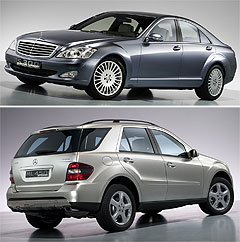Future models - Mercedes-Benz - F700First look: Benz reveals its alternative-fuel futureFuture car: F700 previews new style and hybrid tech for Benz. Mercedes slams down its 2010 roadmap for cars powered by diesel, hybrid and both10 Sep 2007 MERCEDES-BENZ will keep its performance fans enthused by using this week’s Frankfurt motor show to launch both the 6.2-litre V8-powered C63 AMG sedan and the redesigned C-class Estate, another obligatory AMG version of which will also make its world debut on September 11. But the hallowed German car-maker will also signal its green intentions and live up to its reputation as a technology leader by presenting new fewer than seven hybrid vehicles across five model series, plus eight new clean-burning diesel newcomers and the F700 concept, which employs both diesel and hybrid technology – and heralds a new design direction. What’s more, Mercedes will also use its home-turf motor show to announce the series production of its first fuel cell vehicles from as early as 2010. BMW has already launched a hydrogen-powered 7 Series in Europe, but is yet to produce a vehicle resulting from the three-way collaboration between itself, DaimlerChrysler and General Motors involving the development of hybrid technology.  From top: S300 and ML450 Bluetec Hybrids. From top: S300 and ML450 Bluetec Hybrids.At this stage it appears Porsche, via its Cayenne Hybrid SUV developed in tandem with Volkswagen and Audi (under the BlueMotion banner), is likely to win the race to become the first European petrol-electric vehicle to be sold in Australia – by 2010. Attempting to trump it is the ML450 Hybrid, which makes its global debut at Frankfurt before going on sale as “the most economical two-mode petrol hybrid SUV worldwide” in 2009. Mercedes’ direct response to the petrol-electric Cayenne, the ML450 is billed as the “first German two-mode petrol hybrid SUV on the market” because, unlike the Porsche, it can drive with electric power alone, at least for short periods. The 2009 ML450 is claimed to consume just 7.7L/100km (with equivalent CO2 emissions of 185g/km) despite offering a combined system output of 277kW and 480Nm of torque – 195kW from its six-cylinder petrol engine and 41kW from each of its two electric assistance motors. To be presented at Frankfurt alongside hybrid examples of the new C-class, the ML450’s modular hybrid drive system can be employed in tandem with both petrol and diesel engines. Mercedes’ latest diesel technology will also be out in force at Frankfurt - without electric assistance - in the shape of Bluetec examples of the E-class, C-class, M-class and GL-class. Bluetec, a modular exhaust gas purification system that is claimed to deliver the world’s cleanest diesel power and has been available since 2005 in commercial vehicle applications around the globe, made its global passenger car debut in the E320 Bluetec in October 2006 in the US, where it was voted “World Green Car 2007”. Now it is Europe’s turn to get super-clean V6 diesel power, with Benz to use Frankfurt to launch the E300 Bluetec, which is being billed as the world’s cleanest and most economical diesel passenger car in the business limousine segment worldwide. The E300 Bluetec – along with the R, ML and GL320 Bluetec models that will follow it in the US from 2008 - meet EU5 emissions standards not due to come into force until 2011, as well as the stringent US BIN5 emissions standard for 50 US states. It also has “the potential” to meet EU6 regulations due in 2015. Based on the E320 CDI, the E300 Bluetec’s 3.0-litre V6 turbo-diesel produces 155kW and 540Nm of torque. It sprints to 100km/h in a claimed 7.2 seconds and has a 244km/h top speed, yet consumes just 7.3L/100km. Mercedes has also combined Bluetec diesel technology with its modular hybrid drive system to create the S300 Bluetec Hybrid, which is billed as “the world's most efficient, most environment-compatible premium passenger car”. The S300BH combines a four-cylinder engine with a hybrid module to develop a combined system output of 165kW and a strapping 560Nm. Incredibly, however, it consumes just 5.4L/100km - equivalent to just 142g/km of CO2, which is 57g/km or 30 per cent less than the current consumption and emissions benchmarks in the limousine segment. Finally, lurking beneath the F700 Concept’s eyebrow-raising new angular exterior is the best of both Mercedes worlds: a two-mode hybrid propulsion system and the latest diesel technology. Described as a low-emissions, low-consumption luxury sedan, the F700 research car combines hybrid drive with 190kW 1.8-litre “DiesOtto” turbo-diesel power to produce just 127g/km of CO2 emissions. The similarly-sized Lexus GS450h petrol-electric sedan produces 186g/km. It also returns 5.3L/100km – about the same as a small diesel car. “Our customers can rest assured that their Mercedes will also in future meet the most stringent requirements in terms of safety, comfort and effortless superiority, and that they will do so with exemplary green credentials,” said chairman of the board of DaimlerChrysler, Dr Dieter Zetsche, who will present 19 new models at Frankfurt under the slogan “Fascination and Responsibility”. Finally, DCX’s micro-car brand Smart will use Frankfurt to present a special model to mark the production start of the new ForTwo Micro Hybrid Drive (MHD). Based on the new ForTwo coupe, it adds a stop-start electric function to the standard model’s 52kW engine to return 0.4L/100km less fuel (4.3L/100km). Demand in the US and Europe means it is unlikely Australians will get access to any of the Mercedes-Benz technology to be revealed at Frankfurt – including Bluetec diesels and Bluetec diesel-hybrids, let alone fuel cell vehicles – before well into next decade. Read more:Petrol donk, diesel genesClean engines stall Fire over fuel |
Click to shareMercedes-Benz modelsResearch Mercedes-Benz Motor industry news |














Facebook Twitter Instagram